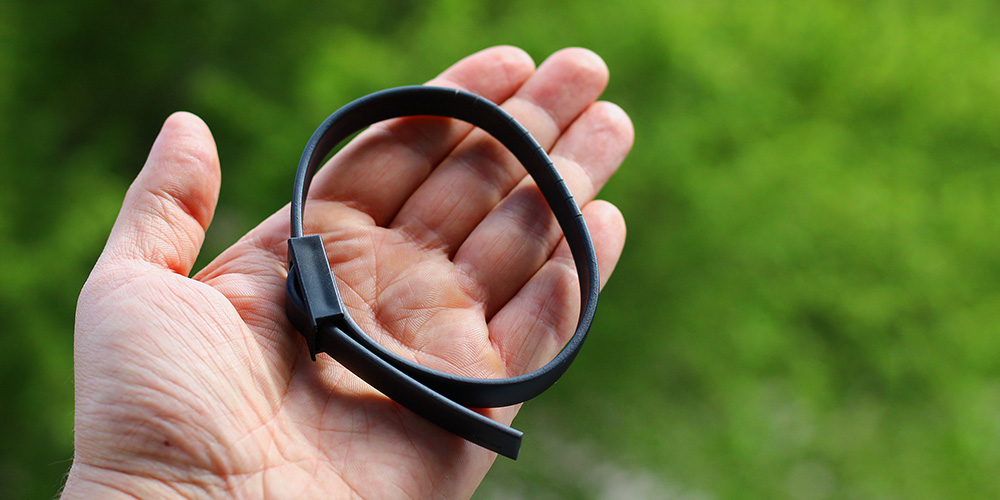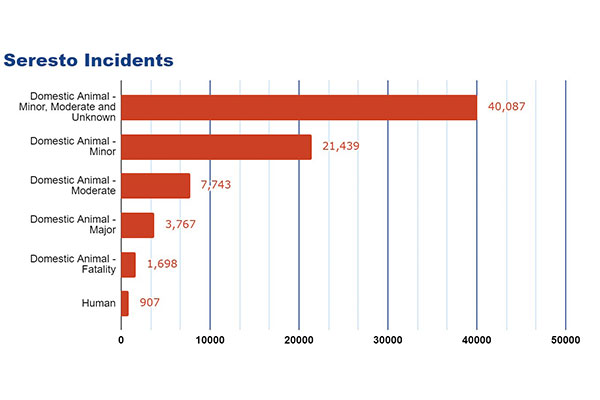Join the conversation on our Facebook page and follow us on Instagram!
Pet owners everywhere are left horrified. The Seresto flea collar is connected to almost 1,700 pet deaths across the country! Not only this, but there have been over 1,000 reports claiming this flea collar can also cause harm to humans. Concerned pet owners share their stories below.
Owner Rhonda Bomwell claims her nine-year-old Papillon service dog, Pierre, suffered a seizure from the collar. Pierre is mostly an indoor animal, so it couldn’t have been from something outside. Bomwell was making dinner when Pierre collapsed. She administered CPR immediately and called the police. By the time the police vehicle had arrived and taken him to the hospital, Pierre had tragically passed away.
Bonwell had never used a tick and flea collar before. Her veterinarian had recommended it only recently, so she had gone to her local pet store and selected Bayer’s Seresto flea collar. Pierre had his seizure just one day after wearing the collar. Bonwell hadn’t thought to connect the new flea collar to the death of her dog, and had left the product on throughout the entire incident. Such a tragedy!
Seresto a Danger to Pets
The U.S. Environmental Protection Agency proves that Seresto is a danger to humans and pets alike. They have known this fact for some time now, and yet, the EPA have failed to inform the public of its potential risk.
Seresto works by releasing a small amount of pesticide onto the animal for a certain length of time, usually several months. The pesticides are supposed to target ticks, fleas, and other pests. They are not supposed to harm your pet. However, we can see this is not the case.
The Center for Biological Diversity accessed public documentation showing that thousands of pets were at risk while using this product. As they are a non-profit organization that protects endangered animals, they also monitor the EPA for ethicality. Clearly, they have found viable evidence against them.
EPA Failing to Regulate Its Products
The U.S. Environmental Protection Agency is in charge of regulating its products, particularly those containing pesticides. They have known about these incidents for years, but have chosen to remain silent. If they had only warned the public of the Sereso collar’s risks, then so many pets would have remained safe.
Retired EPA employee, Karen McCormack, worked as both a communications officer and scientist. She confirms the EPA’s knowledge of this danger, stating that the Seresto flea collar has had the most incidents out of any other pesticide pet products.
The Seresto Flea and Tick Collar, developed by Bayer and now sold by Elanco, was first introduced in 2012. Since then, the EPA have received reports of nearly 1,700 pet-related deaths. Additionally, the agency has received more than 75,000 similar reports as of late. These incident reports include human harm, too. All of these incidents are related to the Seresto Flea and Tick Collar.
The EPA’s Response
The EPA have declined to discuss how other pet products compare with Seresto. An EPA spokesperson detailed with USA Today as to whether or not the product is safe. They admit that the two pesticides in Seresto have “been found eligible for continued registration”. This fact is based on actual incident data and the best available scientific study.
EPA stated that “no pesticide is completely without harm.” They assure viewers that measures are put in place to reduce risk. The product label, for example, specifies these risks and measures, as stated by government law. “Some pets, however, like some humans, are more sensitive than others and may experience adverse symptoms after treatment,” they continue.
Many comments followed this statement, but the EPA refused to respond. People still want to know how Seresto compares with other flea and tick collars, especially when it comes to incident counts. As a result, the Midwest Center filed for a Freedom of Information request in order to take a closer look at the incident database. This request, however, has not yet been filled.
Amazon’s Response
The Seresto flea collar is currently a top seller on Amazon, who has yet to respond to complaints. Many customers are experiencing significant problems in regards to this product and many have complained online. One common complaint is that the collar causes skin rashes and other skin-related irritations to their pets. More severe complaints have reported signs of neurological issues in their pets shortly after administering the collar.
Similarly to EPA, Amazon has chosen not to remove the product from their marketplace. Additionally, they have also chosen to decline requests for comment in regards to the story. Amazon is clearly unconcerned with these present warnings and complaints.
An Ongoing Problem
This is clearly an ongoing problem, as the National Resources Defense Council had filed a petition against the EPA over a decade ago. Back then, they were against the EPA’s approval of another pesticide, known as tetrachlorvinphos, and that had been linked to brain development issues and cancer in children.
Back in April, a federal appeals court called for EPA to respond to the NRDC’s request. They had 90 days to decide whether or not to ban the pesticide. The EPA later decided not to ban this particular pesticide, and which is different to that found in Seresto. This decision resulted in the continued use and sale of these dangerous products. The pesticide is currently being sold under the brand name Hartz InControl, Hartz Ultraguard, and Longlife by Hartz. A lawsuit ensued following this decision, having been challenged by the NRDC, and is still underway.
Seresto Incidents
Comparatively, the number of incidents linked to tetrachlorvinphos is still far fewer than those linked with Seresto. The EPA received around 4,600 incident reports regarding the pet collars with tetrachlorvinphos, but that was back between 1992 and 2008. These incidents included 363 deaths, as shown by EPA documents.
When put alongside the number of incidents and deaths connected to Seresto, this equates to 30 times fewer incidents per year, and 10 times fewer deaths. Take a look at the chart below for further details.
Nathan Donley, an expert in U.S. pesticide regulation and a senior scientist for the Center for Biological Diversity, said these are numbers are “just the tip of the iceberg”. Donley believes the EPA has undercounted the numbers to soften the blow.
Don Lee from USA Today says: “If this doesn’t trigger a concern, that’s a fundamental problem. The fact that EPA has not done anything to alert the public that there might be an issue here strikes me as bordering on criminal. The EPA has this system in place to compile information and it’s just collecting dust in some database.”
The Enormous Scale of Bayer and Elanco
In 2019, the Bayer annual report displayed a revenue of more than $300 million earned on Seresto sales alone. Bayer, a German pharmaceutical company and agribusiness, later sold their animal health division to Elanco Animal Health. As a former subsidiary to Elie Lilly and Co., Elanco Animal Health bought Seresto for $7.6 billion.
Additionally, Bayer also received $2.3 billion of Elanco stock. They’ve said this would be sold over time. Bayer has elected not to comment further.
According to the Center for Responsive Politics, a nonprofit website used to track political contributions, Elanco has chosen to lobby the EPA’s quarterly issues regarding animal health. Records also show that this company has spent $1.6 million to continue lobbying these complaints.
Elanco’s Response
Elanco spokeswoman, Keri McGrath, responded to this matter. She says that Elanco “takes the safety of their products very seriously and thoroughly investigates potential concerns relating to use.” McGrath adds that, “the majority of these incident reports relate to non-serious effects, such as application sight disorders, reddening of the skin, or hair loss below the collar.”
Keri McGrath also pointed out that regulatory authorities in more than 80 countries have approved the product and that the EPA is currently in the final stages of re-approving both pesticides. There is currently no timeline on when to expect this re-approval.
“Keep in mind that the existence of an adverse report does not necessarily mean the product caused the problem,” says McGrath. “Causality between the observed signs and the use of the product is evaluated on a case-by-case basis. That said, every adverse event collected, regardless of causality, is reported to the authorities.”
Multiple Pesticides Made More Toxic When Combined
Seresto contains a combination of two pesticides: imidacloprid and flumethrin. When combined, these pesticides become much more toxic. The use of both pesticides were approved for use in the Seresto flea collar back in 2012. These collars are designed to be effective for only eight months.
Under the Federal Insecticide, Fungicide, and Rodenticide Act, the EPA is required to weigh the harms against the benefits of said products. That way, they can better assess the risks to human and animal health. Only then can they determine if the final products can cause “unreasonable effects on the environment”. API documentation shows flumethrin as an active ingredient in one product alone. That product is Seresto.
Imidacloprid belongs to the neonicotinoid class of insecticides, which are the pesticides most commonly used on United States crops. This particular pesticide is banned in the European Union. It massacred many non-target insects, including butterflies and bees. However, it is still allowed in pet collars, despite the mounting evidence that it can be harmful to mammals.
Combined Pesticides Produce Synergistic Effect
A 2012 Bayer study found that imidacloprid and flumethrin have a “synergistic effect”. This means that these two pesticides are more toxic to fleas when combined and can work as quickly as six hours to stop fleas feeding on an animal. EPA officials say this helps to avoid disease transmission.
Donley from the Center for Biological Diversity said that this “synergistic effect” is likely to extend to pets as well, and not just fleas. It is certain there appears to be something wrong with this product. He also possesses a doctorate in cell and development biology, so knows what he’s talking about.
Registration data for Seresto only looked at each pesticide individually. Bayer analyzed the effects of the Seresto collar on eight domestic dogs and cats. The EPA used these studies to approve Seresto. The California Department of Pesticide Regulation had specifically taken issue with the validity of these studies. However, the EPA chose to approve the collar anyway.
Examples of Severe Human Incidents
Incident reports involving 907 injured humans occurred between 2013 and 2018. The more recent EPA assessment determined that 19 of these incidents were severe. Eight of these people had suffered from dermal symptoms, such as hives or rashes. Alternatively, seven people experienced neurological symptoms, including headaches and even numbness.
There are several more severe cases listed below:
- A 67-year-old woman reported heart arrhythmia and fatigue after sleeping in a bed with her dog, who wore the flea collar.
- Furthermore, a 12-year-old boy experienced seizures and vomiting after sleeping in a bed with a dog wearing a flea collar. He required hospitalization.
- Lastly, a 43-year-old man developed throat and nasal irritation, as well as ear drainage, after sleeping with four of his flea-collared dogs. He had also handled four other collars. His doctor told him he had a hole in his ear drum. The collars were removed and the man’s symptoms have gone away.
The EPA Response to Concerns Regarding Children
In 2016, the U.S. Environmental Protection Agency put out a bulletin responding to concerns with children who had been exposed to the Seresto flea collar. They said they found any exposure to the collars negligible. Can you believe it!
Here’s what the bulletin said: “As stated in the precautions on the label, do not allow children to play with the collars. In addition, try to keep the pet away from young children for a day after putting on the collar to minimize exposure.”
How to Report an Incident to the EPA
You can only report an incident to the EPA if you first find the problem. If someone, or their dog, experiences a issue like the ones mentioned above, then they must connect it to the collar before reporting. People purchasing these collars should understand who to contact should something happen. Unfortunately, many people do not realize these symptoms are a result of the flea collar, particularly if it involves a human. Watch your dog or cat; make sure they are not experiencing symptoms. When you see wrong, you must take the time to report the issue. Otherwise, it results in lower incident numbers. The only way to make the EPA take this issue seriously is to report, report, report!
To contact their hotline, or even ask for advice on these flea collars, simply visit here: EPA Hotlines | U.S. Environmental Protection Agency | US EPA
These types of incidents should not be happening on such a large scale. Be sure to contact the EPA and ensure your voice is heard. Any and all reports can go a long way towards helping to avoid these problems in the future.









